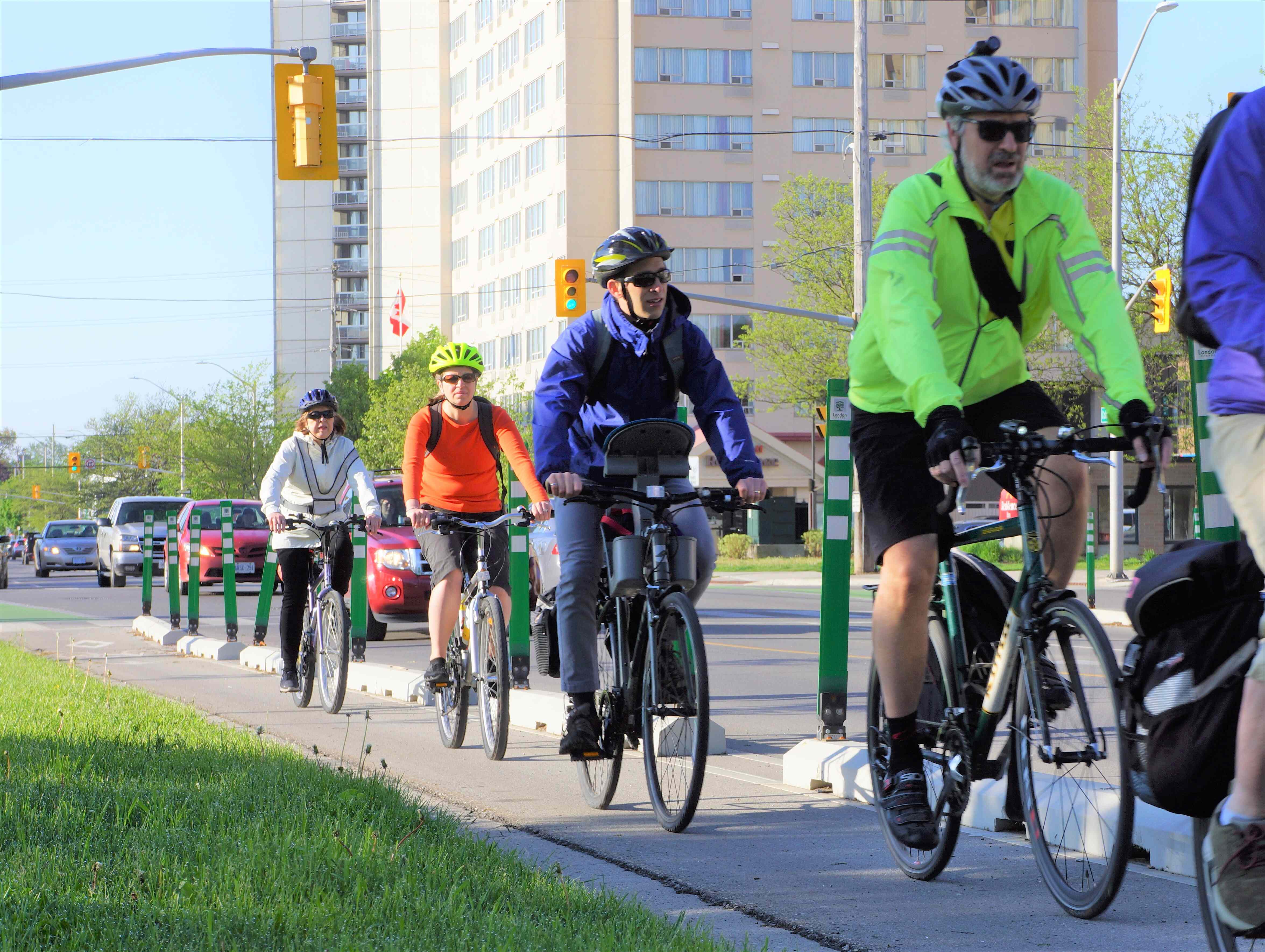Cycling projects
The City is building cycling connections that will enable you to cycle comfortably to more destinations around London.
Image
The official website for the City of London, Ontario
Cycling is an important priority for the City and supports London's transportation and climate goals. About 10 kilometres of new bike lanes are being built in 2023.
Different types of cycling improvements continue to be made each year to connect more neighbourhoods and local destinations. Some of this work may include upgrading intersections, improving the road surface, or constructing cycle tracks. Cycle tracks are bike lanes separated from vehicle traffic and distinct from sidewalks. They can also sometimes be protected with concrete barriers along the bike lane.
This work will help create more safe and attractive options for people to get around London.
This project downtown adds new cycling facilities on Central Avenue between Richmond Street and William Street, and will resurface Central Avenue from Maitland Street to William Street.
The City is adding cycle tracks to Bradley Avenue between Jalna Boulevard West and Montgomery Road. The project will accommodate cycling for all ages and abilities; enhance connections to nearby parks, schools and green spaces, and support different forms of mobility. Future projects will make a continuous cycle track from Wonderland Road to Wellington Road by 2025.
This project will provide cycling facilities on Cheapside Street between Richmond Street and Adelaide Street through a combination of in-boulevard, protected, and painted cycling lanes on both sides of the road. It completes a missing link in the cycling network that connects Western University, St. Joseph’s Hospital and Fanshawe College.
This project is replacing the existing Victoria Street Bridge on Ridout Street next to Thames Park with a new structure that includes a widened deck surface to better accommodate cyclists, pedestrians, and improved connectivity with the Thames Valley Parkway.
To extend the connectivity of the existing protected bike lanes on Colborne Street, a project is planned to add painted bike lanes to Colborne Street between Cheapside and Oxford Streets. This will expand the core cycling network and connects to the project on Cheapside Street.
Below are a few examples of the improvements the City has made to cycling infrastructure in recent years:

Improvements were made in 2022 to traffic and cycling infrastructure on Brydges Street, Wavell Street, and Saskatoon Street.
This project constructed protected bike lanes, upgraded traffic signals, and improved intersection design and transit stops. The bike lane also connects many key destinations in the area such as East Lions Community Centre, Clarke Road Secondary School, Argyle Mall and Kiwanis Park.
A pedestrian signal was constructed in 2022 at the intersection of William Street and Oxford Street allowing people walking and cycling to cross Oxford Street safely. The crossing includes concrete barriers protecting cyclists waiting to cross.

This project in 2022 along the Ridout Street bike lane added new features to the intersection to help improve safety for cyclists and pedestrians. Concrete barriers help protect cyclists waiting to cross, reduce the distance to cross, and slow down the speed of turning drivers.
Improvements were made in 2022 to the protected bike lane on Queens Avenue between Quebec Street and Maitland Street to switch the location of the bike lane and the on-street parking area, and to provide a smoother road for all road users.
In-boulevard bike lanes were added to both sides of Ridout Street between Fullarton Street and King Street in 2022, as part of the Downtown Loop construction project.
The Dundas cycle track connects downtown with Old East Village by creating a separated east-west cycling route on Dundas Street between Wellington Street and Adelaide Street North. The west end of the project connects into Dundas Place and the east end of the project connects into another separated bike lane through Old East Village along Dundas Street between Adelaide and Ontario Streets.
This project was completed in 2021 and included constructing a protected intersection where Dundas Street meets Colborne Street.

The Dundas Street - TVP Connection project improves the link for pedestrians and cyclists between the Thames Valley Parkway (TVP) and Dundas Place downtown, making it easier to reach existing transit routes, as well as planned rapid transit stops for this area. The project was completed in 2021 and included adding separated bike lanes along Riverside Drive, as well as traffic signal upgrades in the area.

In 2018, a protected bike lane was constructed on Colborne Street between Horton Street and Dufferin Avenue. In 2021, the Colborne Street cycle track was extended further north to Oxford Street East connecting different neighbourhoods to the existing protected cycling infrastructure.
A project is planned to add painted bike lanes to Colborne Street between Cheapside and Oxford Streets to expand the bike lane and connect to new cycling improvements on Cheapside Street.

Two bridges and a new multi-use trail were opened in 2020 along the Thames Valley Parkway. These improvements allow Londoners to cross the Thames River between Ross Park and the North London Athletic Fields for the first time.
The bridges and multi-use trail can be accessed from the west through Ross Park off of Richmond Street. From the east, residents can reach the area from the North London Athletic Fields located on Adelaide Street at Kipps Lane.